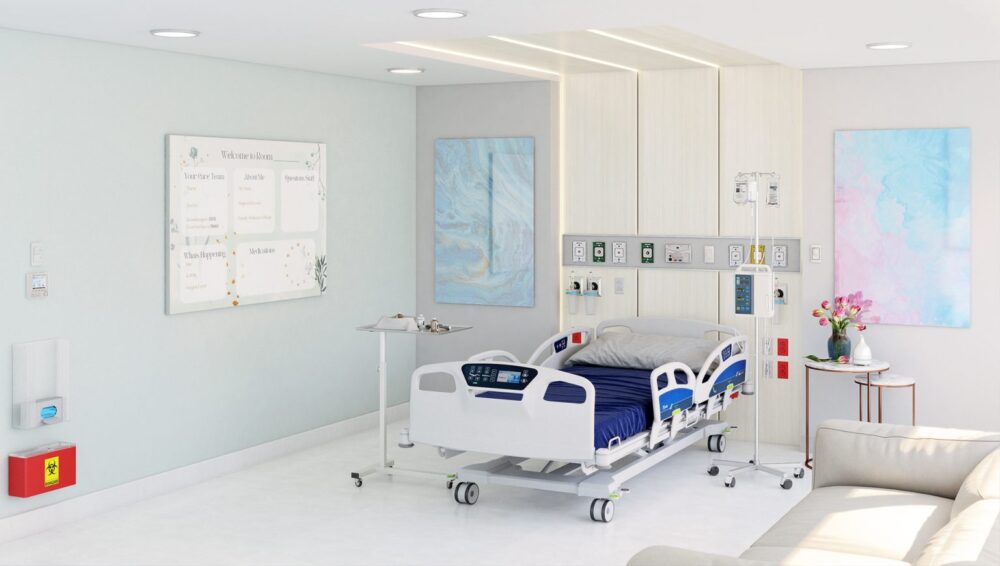Supporting Healthcare Through Color and Design
Visits to the doctor’s office or the hospital are often tied to negative feelings and conceptions. Having to visit a clinic or hospital usually means there is something physically wrong, which in turn causes strain on mental health. Healthcare environments can do more to increase overall mental and emotional wellbeing to ease the stress that often accompanies these kinds of visits. People come to healthcare spaces to heal, and the environment should help put patients in the right mindset to focus on healing. Thoughtfully designed spaces can lead to a better care experience by focusing on a person’s mental state, which can be accomplished through color, visuals and design.
Color
Hospitals and doctors’ offices are often associated with scenes of cold, bleach-white, and hard surfaces. Settings can amplify emotions, and if the environment feels negative it will strengthen an already blue mindset. As research suggest, the right colors can have a profound impact on how we think and feel. It can raise someone’s mood and mindset, which can leave someone feeling more optimistic to focus on the healing process.
Color can be perceived differently among different cultures, so choosing a color palette may depend on location. While perceptions of color are subjective, there is a generalization of some colors that have universal meanings. One 2020 study surveyed the emotional connotations of colors from a group of 4,598 people from 30 different countries. The study found that people commonly associate certain colors with certain emotions.
Colors that encourage serenity and calmness can prompt a mindset to relax. Pantone’s 2016 colors of the year, Rose Quartz and Serenity, were colors found to promote a peaceful mindset.
“Rose Quartz, a warm and embracing gentle rose tone that conveys compassion and a sense of composure and Serenity, a cool and tranquil blue which comforts with a calming effect. Joined together this harmonious pairing of inviting shades reflects connection and wellness, conveying a message of a soothing sense of order and peace.” – Pantone (2016) Rose Quartz and Serenity Embody the Tranquility and Inner Peace Consumers Yearn For
Walls demand color. Wall space is something that should never be overlooked in design. Beyond just painting the wall, the products and accessories you mount on the wall should also consider color. As patients seek mindfulness and well-being as an emotional or spiritual antidote to their stress, colors may psychologically fulfill the need for reassurance.
Imagery
In addition to color, the imagery and visuals in health spaces can also influence a person’s mood. Nature and art can play a big role to help people heal. Environments with artwork depicting scenes of familiar landmarks or nature can reduce stress and improve patient outcomes. Art that elicits a thoughtful response or even begins a conversation can provide a distraction or escape from current stressors. Healthcare settings are also inundating a person with information, which can be stressful. Art can alleviate the overload of sensory information in a busy healthcare setting by providing a focal point for emotional relief. Color and art can also impact the staff and their emotional well-being as they deal with the difficulties of the day. If the staff behavior is positive, it will in turn affect those they are caring for.
Wall space is, again, perhaps the best way to incorporate imagery. With the intensified focus on cleanability post-pandemic, walls may need a regular deep cleaning. Printed glass boards are guaranteed to clean and durable, and are able to keep your artwork intact. With surfaces that are easier to clean and sanitize, it makes it easier to prevent germ transmission in high traffic areas. Wall-coverings using glass boards can also be printed with wayfinding, branding, or creating colorful environments.
Final Thoughts
Designing healthcare spaces with color and art support patients, and the staff who work in healthcare spaces, by reducing a person’s stress. Color and art can lead to health spaces being more welcoming, and can help put patients in the right mindset to focus on healing.

